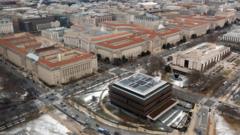US President Donald Trump has recently signed an executive order aimed at redefining the narrative presented at the Smithsonian Institution, which includes more than 20 museums and research centers that attract millions of visitors annually in Washington D.C. and New York City. This new directive instructs the vice president to ensure the removal of what Trump deems "improper, divisive, or anti-American ideology" from the exhibits and galleries within the Smithsonian's purview, including the National Zoo.
Dubbed "Restoring Truth and Sanity to American History," the order tasks Vice-President JD Vance—an ex officio member of the Smithsonian Board of Regents—with spearheading this initiative. Trump’s directive also calls for the restoration of federal properties that he believes have been unjustly altered or removed in recent years, asserting that such changes contribute to a misleading version of the nation's history.
The order criticizes specific museums, claiming that the American Women's History Museum, now in development, is set to promote an agenda of gender identity that clashes with traditional views. Furthermore, Trump's administration has singled out the National Museum of African American History and Culture, alleging that it portrays key values such as hard work and the nuclear family as "White culture,” igniting further contention over the portrayal of African American history.
The Smithsonian, which hosts 21 diverse museums, provides complimentary entry to an impressive 15 to 30 million visitors each year, including notable sites like the National Museum of American History and the National Portrait Gallery. Aside from the Smithsonian's focus, the order also mandates enhancements to Independence Hall in Philadelphia, as the nation prepares for the 250th anniversary of the Declaration of Independence's signing.
Trump's latest move aligns with his broader strategy to combat what he characterizes as "woke" left-centric ideologies. It follows a series of other executive orders aimed at dismantling diversity and inclusion efforts within federal programs, sparking legal scrutiny and backlash from a variety of stakeholders, including those in the arts community. This new understanding of historical preservation and representation of culture not only raises questions about the future of public education but also the continued evolution of American identity.





















